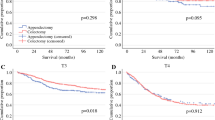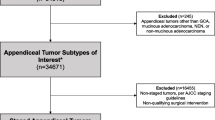Abstract
Background
The aim of this study is to evaluate the epidemiology of and prognostic factors for appendiceal carcinomas (ACs).
Methods
All cases of ACs registered in the Surveillance, Epidemiology, and End Results (SEER) database from 1973 to 2014 were retrospectively identified in this study. Age-adjusted incidence and survival rates were calculated.
Results
We analyzed 7170 patients with ACs. We observed a significant increase in the reported annual age-adjusted incidence of ACs from 1973 (0.18/100,000) to 2014 (1.11/100,000). The elevation of the incidence was noted in all the histological types, stages, and grades. The most common histological type varied by race, with the appendiceal mucinous adenocarcinoma (AMA) being the most common in white, Asian/Pacific Islander, and American Indian/Alaskan Native patients, and the appendiceal adenocarcinoma (AA) being the most common in African American patients. In multivariate analysis of patients with all ACs, gender (P < 0.001), year of diagnosis (P < 0.001), age (P < 0.001), race (P < 0.001), tumor grade (P < 0.001), disease stage (P < 0.001), retrieved regional lymph nodes (P < 0.001), type of surgery performed (P = 0.002), and histologic subtype (P < 0.001) were predictors of outcome. Survival time for all ACs increased from the 1973–1993 period to the 1994–2014 period (HR 0.76; 95% CI, 0.69 to 0.85). Additionally, the 5-year survival rates were 88% for malignant carcinoid, 70% for goblet cell carcinoid, 51% for colonic type adenocarcinoma, 59% for mucinous adenocarcinoma, and 25% for signet ring cell type.
Conclusions
We observed increased reported incidence of ACs and increased survival durations over time, suggesting that clinicians pay more attention to ACs and mastering the characteristic of these tumors.



Similar content being viewed by others
References
Siegel RL, Miller KD, Jemal A (2018) Cancer statistics, 2018. 68(1):7–30
Khan F, Vogel RI, Diep GK, Tuttle TM, Lou E (2016) Prognostic factors for survival in advanced appendiceal cancers. Cancer Biomark 17(4):457–462
Smeenk RM, van Velthuysen ML, Verwaal VJ, Zoetmulder FA (2008) Appendiceal neoplasms and pseudomyxoma peritonei: a population based study. Eur J Surg Oncol 34(2):196–201
Deans GT, Spence RA (1995) Neoplastic lesions of the appendix. Br J Surg 82(3):299–306
McCusker ME, Cote TR, Clegg LX, Sobin LH (2002) Primary malignant neoplasms of the appendix: a population-based study from the surveillance, epidemiology and end-results program, 1973-1998. Cancer. 94(12):3307–3312
Noone AM, Lund JL, Mariotto A, Cronin K, McNeel T, Deapen D, Warren JL (2016) Comparison of SEER treatment data with Medicare claims. Med Care 54(9):e55–e64
Marmor S, Portschy PR, Tuttle TM, Virnig BA (2015) The rise in appendiceal cancer incidence: 2000-2009. J Gastrointest Surg 19(4):743–750
Buuren SV, Groothuis-Oudshoorn K (2011) Mice: multivariate imputation by chained equations in R. J Stat Softw 45:1–67
Marshall A, Altman DG, Holder RL, Royston P (2009) Combining estimates of interest in prognostic modelling studies after multiple imputation: current practice and guidelines. BMC Med Res Methodol 9:57
Kocher KE, Meurer WJ, Fazel R, Scott PA, Krumholz HM, Nallamothu BK (2011) National trends in use of computed tomography in the emergency department. Ann Emerg Med 58(5):452–62 e3
Phillips KA, Liang SY, Ladabaum U, Haas J, Kerlikowske K, Lieberman D, Hiatt R, Nagamine M, Van Bebber SL (2007) Trends in colonoscopy for colorectal cancer screening. Med Care 45(2):160–167
Benedix F, Reimer A, Gastinger I, Mroczkowski P, Lippert H, Kube R, Study Group Colon/Rectum Carcinoma Primary T (2010) Primary appendiceal carcinoma--epidemiology, surgery and survival: results of a German multi-center study. Eur J Surg Oncol 36(8):763–771
Piso P, Bektas H, Werner U, Schlitt HJ, Kubicka S, Bornscheuer A, Manns M, Klempnauer J (2001) Improved prognosis following peritonectomy procedures and hyperthermic intraperitoneal chemotherapy for peritoneal carcinomatosis from appendiceal carcinoma. Eur J Surg Oncol 27(3):286–290
El Halabi H, Gushchin V, Francis J, Athas N, Macdonald R, Nieroda C, Studeman K, Sardi A (2012) The role of cytoreductive surgery and heated intraperitoneal chemotherapy (CRS/HIPEC) in patients with high-grade appendiceal carcinoma and extensive peritoneal carcinomatosis. Ann Surg Oncol 19(1):110–114
Sugarbaker PH, Graves T, DeBruijn EA, Cunliffe WJ, Mullins RE, Hull WE, Oliff L, Schlag P (1990) Early postoperative intraperitoneal chemotherapy as an adjuvant therapy to surgery for peritoneal carcinomatosis from gastrointestinal cancer: pharmacological studies. Cancer Res 50(18):5790–5794
Chua TC, Moran BJ, Sugarbaker PH, Levine EA, Glehen O, Gilly FN, Baratti D, Deraco M, Elias D, Sardi A, Liauw W, Yan TD, Barrios P, Gomez Portilla A, de Hingh IH, Ceelen WP, Pelz JO, Piso P, Gonzalez-Moreno S, Van Der Speeten K, Morris DL (2012) Early- and long-term outcome data of patients with pseudomyxoma peritonei from appendiceal origin treated by a strategy of cytoreductive surgery and hyperthermic intraperitoneal chemotherapy. J Clin Oncol 30(20):2449–2456
Acknowledgments
The authors would like to thank the Surveillance, Epidemiology, and End Results (SEER) database for the support.
Funding
This study was supported by the National Key R&D Program of China (No. 2016YFC0905300 and 2016YFC0905301), the Grant of Science and Technology Commission of Shanghai Municipality (No. 16401970502), the Grant of National Natural Science Foundation of China (No. 81572351), the Shanghai Shenkang Program (No. SHDC12014206), the National Science Foundation of China (No. 81702353), and Shanghai Municipal Natural Science Foundation (17ZR1406400).
Author information
Authors and Affiliations
Corresponding authors
Ethics declarations
Ethics approval and consent to participate
The Ethical Committee and Institutional Review Board of the Fudan University Shanghai Cancer Center reviewed and approved this study protocol.
Competing interests
The authors declare that they have no competing interests.
Disclaimer
The funders had no role in the study design, data collection and analysis, decision to publish, or preparation of the manuscript.
Additional information
Publisher’s note
Springer Nature remains neutral with regard to jurisdictional claims in published maps and institutional affiliations.
Rights and permissions
About this article
Cite this article
Mo, S., Zhou, Z., Ying, Z. et al. Epidemiology of and prognostic factors for appendiceal carcinomas: a retrospective, population-based study. Int J Colorectal Dis 34, 1915–1924 (2019). https://doi.org/10.1007/s00384-019-03387-y
Accepted:
Published:
Issue Date:
DOI: https://doi.org/10.1007/s00384-019-03387-y




